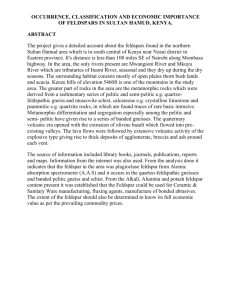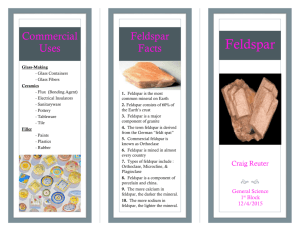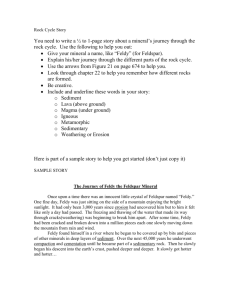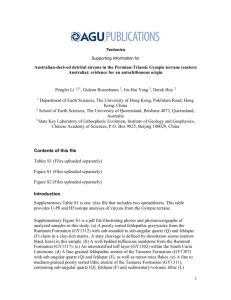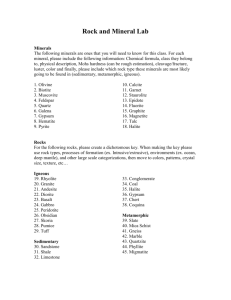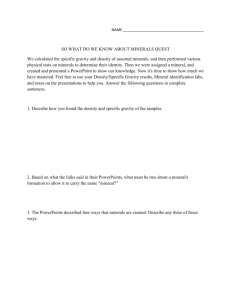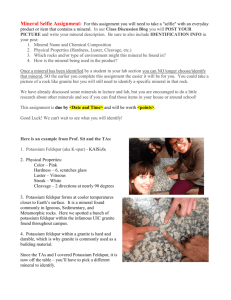FELDSPAR IN RAJAS THAN
advertisement
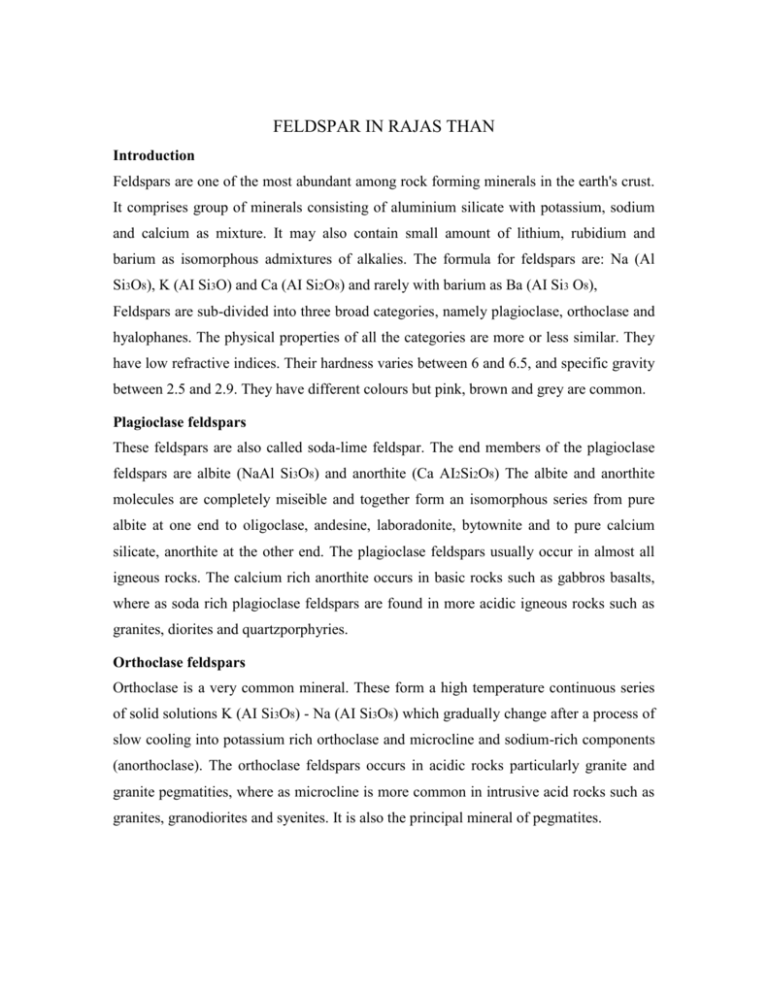
FELDSPAR IN RAJAS THAN Introduction Feldspars are one of the most abundant among rock forming minerals in the earth's crust. It comprises group of minerals consisting of aluminium silicate with potassium, sodium and calcium as mixture. It may also contain small amount of lithium, rubidium and barium as isomorphous admixtures of alkalies. The formula for feldspars are: Na (Al Si3O8), K (AI Si3O) and Ca (AI Si2O8) and rarely with barium as Ba (AI Si3 O8), Feldspars are sub-divided into three broad categories, namely plagioclase, orthoclase and hyalophanes. The physical properties of all the categories are more or less similar. They have low refractive indices. Their hardness varies between 6 and 6.5, and specific gravity between 2.5 and 2.9. They have different colours but pink, brown and grey are common. Plagioclase feldspars These feldspars are also called soda-lime feldspar. The end members of the plagioclase feldspars are albite (NaAl Si3O8) and anorthite (Ca AI2Si2O8) The albite and anorthite molecules are completely miseible and together form an isomorphous series from pure albite at one end to oligoclase, andesine, laboradonite, bytownite and to pure calcium silicate, anorthite at the other end. The plagioclase feldspars usually occur in almost all igneous rocks. The calcium rich anorthite occurs in basic rocks such as gabbros basalts, where as soda rich plagioclase feldspars are found in more acidic igneous rocks such as granites, diorites and quartzporphyries. Orthoclase feldspars Orthoclase is a very common mineral. These form a high temperature continuous series of solid solutions K (AI Si3O8) - Na (AI Si3O8) which gradually change after a process of slow cooling into potassium rich orthoclase and microcline and sodium-rich components (anorthoclase). The orthoclase feldspars occurs in acidic rocks particularly granite and granite pegmatities, where as microcline is more common in intrusive acid rocks such as granites, granodiorites and syenites. It is also the principal mineral of pegmatites. Hyalophanes The hyalophanes are rare orthoclase feldspars containing small quantities of barium. They form an isomorphous series of K (Al Si3O8) and Ba (A12 Si2O8). Among the three feldspars,orthoclase are important from commercial point of view. Most of today's marketed feldspars are mined from pegmatities or feldpathic sand deposits and coarse grained granites. India has abundant resources of feldspar mainly of potash and soda feldspar. A number of occurrences have been noted but the workings of feldspar are confined to the state of Rajasthan, Bihar, Andhra Pradesh, Karnataka, Tamilnadu, Madhya Pradesh and West Bengal. The reserves of feldspar in India as on 1-4-1990 are placed at 16137858 tonnes. About 80% of the total reserves are concentrated in two states i.e. Rajasthan (9867074 tonnes or 61 % of the total), Tamilnadu (2087391 tonnes or 12.93% of the total) and Andhra pradesh 1947454 tonnes or 12% of the total. Rajasthan continued to be leading producing state of feldspar accounting for 56% of the total production followed by Andhrapradesh 31 % Karnataka 8% and Tamilnadu 3%. Occurrences in Rajasthan : Rajasthan is the principal feldspar producing state in the country. There are 127 mining leases for feldspar in the state and about 97724.0 tonnes was produced during the year 1998-99. The description of the deposits in Rajasthan is given below. Ajmer District: Large number of feldspar deposits are known to occur in Ajmer district. The principal occurrences are in Ajmer, Beawar, Nasirabad, Kekri and Kishangarh tehsils, namely at Lohagal, Banar-Sundri, Foy Sagar-Baro, Piproli, Rajgarh, Nagelao, Kalesara, Makrera, Beawar, Lohawara, Dhal, Bhodli, Sanod, Basunbani, Kharwa, Lothiana Surajpura, Soniana, Kishanpura, Jawaja, Kalathera. The feldspar deposit of district Ajmer are largely potash bearing but a few soada feldspar occurrences are also known. The quality of feldspar produced in Ajmer- Beawar area is good with K20 content 11 to 14% and can meet world market standards, The promising areas of Jawaja Group, Makrera-Rajgarh Group and Ti1ora- Piproli Group of mines are the most important feldspar producing areas where good quality feldspar is being mined. The Ajmer district alone produced about 66389 tonnes of feldspar in comparision to the state's production of 97724 tonns in the year 1998-99. Bhilwara district: Feldspar occurs in the mica and beryl mining areas of Jahazpur and Bhilwara. The production of feldspar from this district was 22700 tonnes during1998-99 there area 56 mining leases of feldspar associated with mica in the district. Sikar district: Green variety of feldpar probably microcline has been obtained from Kacharada mines in Nim-Ka-Thana area and the soda feldspar have been obtained from the granite pegmatites of Buchara areas. Other areas are Dudawas, Shipur and Sohanpura. About 2231 tonnes of feldspar has been produced from this district in the year 1998-99. Pali district: In Pali district feldspar deposits are located in Chaondia. Pratapgarh, Dingor, ThandiBeri, Barantkhurd- Girri, Philava areas. Took district: Feldspar may be obtained from all the mica mines of Malpura, Tonk, Toda Raisingh and Duni areas of this district. It is also available from the mica-beryl mines of Kakor area. About 356 tonnes of feldspar production was reported from this district in the year 199899. Alwar district: . A pink variety of potash feldspar is obtained from huge pegmatite intrusion at a distance of about 1.5 kms south of village Tatarpur in Bansur tehsil and in Advas, 16 km from Rajgarh. About 364 tonnes of feldspar was produced during 1998-99. Other occurrences are located in the area of Khairtal, Kirwar, Gothara, Longarwas, Deotana. Bhatokalan, Bhanokhar and Gar. Udaipur district: Feldspar is found in the mica bearing area of Udaipur district. The mineral is mostly soda feldspar and contains Na20 from 13 to 18%. It is found near Sai dam area, Malva ka chorah, Bekariya in tehsil Kotra and Suratpura in tehsil Vallabhnagar. The occurrences are also found in Loharcha area. Occurrences of feldspar have also been reported from Baghol, Padasli & GomtiCharbhuja area (Rajsamand); Sheopura (Jhalawar); Bundela Hills (Jhunjhunu district) Dangarwara, Mundoli, Devapura, Amarpura, Dhagoli, Sakun, Borara, Natata, Barla, Girot (Jaipur district), Padari as Sarod-ka-para area in Sagwara tehsil (Na2O 11.45%) (Dungarpur), Lodha, Lodha Geriya, Laloopada, Jagpura, Nal Ganan and Damarwasa. Industrial Application:Feldspar is traditionally used as a source for alumina and alkali in ceramics & glass applications which account for 85-90% of total consumption of the mineral. It plays an important role as fluxing agents in ceramics and glass applications, and are also used as functional fillers in the paint, plastic, rubber and adhesive industries. Few firms in India are utilising feldspar as a bonding agent in the manufacture of bonded abrasive like wheels and discs of garnet, corrundum, emery etc. It is also used in the manufacture of artificial teeth, fertiliser and white cement. Certain varities of feldspars are used as semi precious stone e.g. moonstone which is orthocase colourless feldspars with white or bluish tints. Ceramics: In ceramics applications, feldspars are used as fluxing agent, softening melting and wetting other batch constituents. Surface tension pulls the remaining solid particles together, giving a densification of the ceramic body with rising temperature the alkalis become more active and first dissolve the clay particles and then the free silica. The flux controls the degree of vitrification of the ceramic body during firing. As different ceramic bodies require different degrees of vitrification, the amount of flux varies accordingly. Potassium feldspar (K-spar) has technical advantages over sodium feldspar (Na-spar), as it forms a melt of high viscosity that decreases only slightly with increased temperature, thereby making ceramics stronger and more refractory K-spars are mainly used in electrical porcelain applications and porcelain enamels. Na-spars are more often used in ceramics because they are cheaper. After clay, feldspar is the biggest ingredient in the raw material batch for ceramic bodies. Typical feldspar contents are <25% in earthernware, 25-35% in sanitary ware, 15-30% in white ware, 10-55% in floor and wall tiles and 30-55% in electrical porcelain. Glass: The alkali content in feldspar acts as a flux, lowering the glass batch melting temperature and thus cutting production cost. But feldspar are primarity added to glass batches for their alumina content. Alumina acts as a matrix former by reducing the tendency for glass to devitrify, and as a stabiliser, which improves the chemical durability of glass and its physical resistance to scratching, bending, breaking and thermal shock. Typical feldspar contents of glass range from 0.05% for flat glass and textile-grade fibreglass, 8% for container glass, 11 % for some speciality glass application, and up to 18% for insulation fibreglass. Refractory: In the refractory industry, feldspar is used as one of the batch constituents in the manufacture of acid proof refractory bricks. It is mixed with fireclay to make the acid proof refractory bricks. Abrasives : Fine grained feldspar is used in abrasive industry as mild abrasive material for incorporation in scouring powders. Although its hardness is around 6, because of its semiconchoidal fracture, it is used as a mild abrasive. In scouring powder, feldspar is preferred to silica sand on considered reasons of better health safety as its silica content is combined and not free. Ground feldspar is used as non-skid dusting agent for city floors. It is also used as a bond in bonded abrasives. Vitrified wheels with a clayfeldspar bond are preferred because of their high rigidity and dimensional stability. Electrode :In welding electrode industry, feldspar is used as a flux. Its fluxing properties make it an ideal ingredient in batch mixes for coating the electrodes. Feldspar, as a flux, is generally incorporated into the dry blend mix for coating electrodes used in the manual metal arc process. Feldspar incorporated into the mix carries out two important functions namely (i) It acts as an arc stabiliser, & (ii) helps in weld pool protection. In the case of weld pool protection, slag formers such as felspar form a molten/solid barrier to protect the weld pool and new weld metal. Feldspar can form between 5 and 10% of the total dey blend mix. In India, mostly potassium felspar is used though in other countries both potassium and sodium bearing feldspar are used. There is an increasing trend for using high potassium bearing feldspar because they give a smoother arc which is important in certain applications. Each type of feldspar gives a unique slag viscosity, but finally it is the manufacture's experience, rather than chemical understanding, that dictates' which felspar affects the viscosity in a particular way. Fillers & extenders: Physical properties, such as good dispersibilty, chemical inertness and stable pH. low free silica content and brightness of 89-95% lend fine ground feldspathic materials excellent filler qualities. However, in this field of application, feldspar complete with other, cheepoo and geographically more converient minerals, including baryter, calcium carbonate kaolin, mica and tale. As aresult a this, feldspathic materials are often considered the second choice in filler & extender applications. On the whole, fillers still represent a small market for feldsparthic minerals, but demand in the paint, plastic and rubber industries is increasing because in paint application that are subject to acidic environment (e.g.out door paints, anti corrosive paint, grout & plasters). Feldspathic minerals provided good film integrity, resistance to abrasion, chemical attack and chalking. In paints, filler-grade feldspars also achieve maximum colour strength through their low tint strength. Other beneficial properties of feldspar in paints and coatings include low viscosity at high pigment loading, low vehicle demand and exceptional resistance to frosting. In plastics, feldspar offer the same physical properties that in paint application. They provide resistance to staining, and their index to refraction is similar to most of the common resins. This refractive index also allows the production of adhesives which dry clear on wood and translucent on glass. Processing: The processing of Fledspars usually involves flotation or magnetic seperation to remove accessory minerals, such as mica, garnet, illmenite and quartz. Silica (SiO 2) occurs as a co-product in the mining of feldspar ores, present as quartz in pegmatite deposits and silica sand in feldspathic sand deposits. In some feldspar applications, however, the presence of silica can be advantageous. Other uses require extremely pure and finely ground grades. The degree of feldspar grinding depends on end-product requirements.Glass grade feldspar is usually the coarsest material, where as filler application demand finely ground feldspars. Statistical Information for fellspar in Rajasthan Year Production Revenue No. of leases. (thous. tons) (thous. Rs.) 1994-95 70.470 4190.0 92 1995-96 71.060 6093.00 98 1996-97 103.320 2825.70 99 1997-98 126.810 3435.05 117 1998-99 97.724 1811.50 127 District wise Production of feldspar (Year:1998-99) S.No. District Production Leases (thous. Rs.) 1 Ajmer 66.389 54 2 Bhilwara 22.700 56 3 Sikar 2.231 5 4 Pali 3.000 3 5 Tonk 0.356 2 6 Jaipur 0.167 6 7 Alwar 0.364 1 8 Rajsamand 1.517 - 97.724 127 Total of Rajasthan Specification: There is no ISI specification for feldspar. Specifications of feldspar in various industries as prescribed by them is as below :Abrasives : Feldspar is used in the form of powder and lumps which have Si02-60% min; A1203- 18% min, and K2O/ Na2O- 10% minimum. While CaO, Fe203 should below 0.6% and 0.45% respectively, LOI should not be more than 2%. Ceramics: It is mainly used as a fluxing agent and white wares contain good proportion of feldspar. There are two grades used, Gr. I should have S102-68% maximum, Fe203 should be below 0.1 % while ratio of K/Na should be 2: 1. In Gr I Si02 is 72% maximum and Fe203 is same as that of Gr. I i.e. 0.1 % max. CaO should be in traces while MgO should not be present. Glass Industry: In glass industry potash felspar is preferred as it introduces potash for clarity and alumina for durability and also controlling viscocity of molten glass. It should contain 1% to 13% of Na2O and K2O combined, 15 to 18% of A1203 65 to 68% of Si02 and Fe2O3 below 0.3% while the size should be 30 to 80% mesh. Refractory: As already mentioned earlier feldspar is added as one of the batch constituents for refractory. Here also 11 to 12 % of combined Na2O and K2O are preferred while Si02 should be within 60&65%, A1203 should be 18 to 19% Fe2O3 should be below 1.5%, PCE=4 orton cone and LOI should be below 0.8% size preferred is 2.5 to 10 cms. Electrodes: Feldspar finds use in electrode manufacture as it acts as a flux and forms slag which protects molten metal from oxidation. For this potash feldspar having 13 to 14% of K2O, I to 3% of Na2O, 63 to 67% Si02, 17 to 20% of A1203 and Fe2O3 upto 0.3% is preferred. LOI should be maximum upto 1 % Size 0.2 to 0.06 mn.
